History
Friday evenings in early 19th Century South Haven were filled with the hustle and bustle of horse and buggies, fruit wagons and an endless stream of well wishers rushing to meet the giant steam boats carrying travelers from Chicago and Milwaukee.
Fringe-top surreys carried vacationers to over 200 of the finest resorts.
Founded in 1787 by Ottawa, Miami and Pottawattamie tribes, the area was christened "Ni-Ko-Nong" which translates to beautiful sunsets. Pioneering times brought J.R. Monroe who founded the area in 1833.
Pioneer families came over the decades to settle with the opening of sawmills. This new industry made hotels, schools, homes, stores and tanneries possible to exist on the banks of the Black River.
The choice lumber was shipped across Lake Michigan to ports in Chicago and Milwaukee and early steamers were built in South Haven shipyards. As lumber gave way, room for fruit growers opened up and soon peach, apple and blueberry farmers made up the Michigan fruit belt.
Visitors came to the area for beaches, weather, entertainment, resorts and an opera house. But it was in the 20's and 30's when commerce exploded in the area. Horse and buggies made way for the automobile. In 1969 South Haven was crowned the World's Blueberry Capital. This title is still held today.
Over the years great progress and prosperity has created a charming village that keeps one hand clasped onto yesteryear while the other stretches out to greet the future.
1833
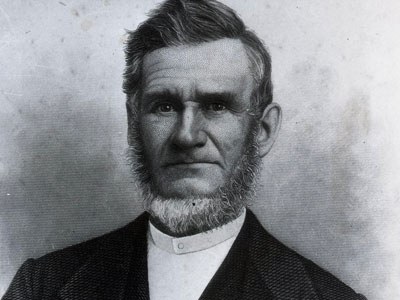
Judge J.R. Monroe envisions the creation of South Haven. He is granted a land patent from the U.S. government for 65 acres of land along the Lake Michigan shore. Monroe and his family arrived by lumber wagon and is believed to have built the first house, a double log cabin, in South Haven located at the mouth of the Black River. The Monroe family later located to nearby Lawrence.
1835
A road is established from South Haven to Paw Paw, MI.
1838
A.S. Dyckman came from New York. A longtime civic leader, Dyckman helped build the first hotel, had partnerships in two sawmills, and developed the first commercial orchard, amongst other accomplishments. Dyckman Park, originally named Morning Glory Park, recognizes his contributions to the growth of the community.
1849
South Haven celebrates the Fourth of July for the first time.
1850
The first steam sawmill is constructed and had one upright saw. It stimulates the growth of an industry that ships lumber across Lake Michigan to Chicago and Milwaukee.
1852
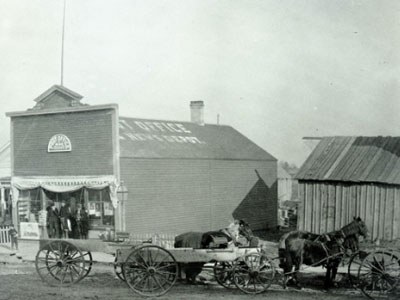
The Village of South Haven is platted. The first one-room schoolhouse is constructed at the corner of Indiana Avenue and Superior Street. A four-room school was built in 1858 to serve seven students. It was followed by Indiana School in 1898 and Hartman School in 1906. A Michigan Historical Site, Hartman is now the home of the Historical Association of South Haven. Central School was built in 1913 and expanded in 1920. In 1961 a new high school was built honoring longtime educator L. C. Mohr. In 2014 voters approved a $37 million bond issue to upgrade the high school and other school facilities.
The first Post Office is constructed. Prior to this South Haven residents had to travel to Lawrence to get their mail. Home delivery of the mail started in 1901. The Post Office relocated to its current location on Broadway Avenue in 1933.The first Methodist sermon is preached in South Haven in the home of a parishioner.
1853
The Forest House is South Haven’s first hotel. Half of the town’s estimated 200 residents lived in the hotel.
1854
Merchants Col. William Hale and Uzziah Conger arrive from Phoenix, N.Y., hence the name Phoenix Street.
1856
The Congregational Church is the first congregation organized in South Haven. First Reformed Church is established in 1872 with services spoken only in Dutch. It was renamed Hope Reformed Church in 1945.
The St. Agnes Guild of the Epiphany Church is formed.
1858
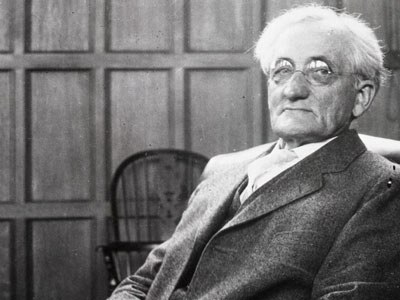
World-famous botanist Liberty Hyde Bailey, Jr. is born in a frame house that is now a museum on Bailey Avenue. In 1984 the museum was designated as a National Historic Site.
1859
The first wooden drawbridge is built across the Black River. It was replaced by an iron swing bridge in 1889. The current Dyckman bridge was opened in 1988.
1860
First commercial shipment of peaches goes to Wisconsin and nets the farmer $17. South Haven Township is chartered.
The first library is started and operated by the South Haven Township clerk.
1861
The citizenry celebrates the Fourth of July with a parade.
1864
Star of the Lake Masonic Lodge is chartered. Liberty Hyde Bailey Sr. was its first Master.
1865
The first two-masted schooner to be built in South Haven is appropriately called the South Haven.
1866
South Haven’s first permanent church building, First United Methodist Church, is constructed. Fire destroyed the building twice (1871 and 1925). The current building is on the original Michigan Avenue site.
Charles P. Ludwig moves his family to South Haven. He built a pier and operated a sawmill. In the fall of 1874 a custom-built schooner was launched in honor of his wife. It was captained by his son Daniel, at the time the youngest captain on the lake at age 19. Daniel would become a billionaire shipping magnate. A 1982 Forbes magazine article would call him America’s richest person. He died in 1992 at age 92.
1867
South Haven’s first newspaper, the South Haven Sentinel, is started. It became the weekly South Haven Tribune in 1897 and became a six-day-a-week paper in 1899. It continues to be published today as a weekly.
April 5, 1869
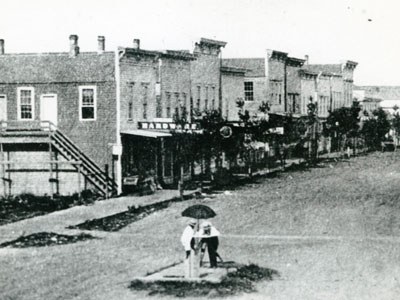
South Haven is incorporated as a village by the Michigan Legislature. South Haven officially becomes a village by local action on May 10. The village was incorporated and re-incorporated in 1871 due to legal technicalities. James David Corrothers is born. He moved to South Haven at the age of 2, where he remained during his school years. He became a recognized literary figure in the 1890’s and was considered a leading African American literary figure by the time of his death in 1917.
May 10, 1869
South Haven officially becomes a village by local action. The first president is George Hannahs.
1869
The south side of Phoenix Street west from Center street is nicknamed “Rotten Row” as most of the establishments were saloons catering to sailors from the many vessels in the harbor.
James David Corrothers is born. He moved to South Haven at the age of two and grew up in the area. He became a recognized literary figure in the 1890s and at the time of his death in 1917 he was considered a leading African American literary figure.
Construction begins on the 30-mile long Kalamazoo & South Haven Railroad. Service between the communities begins on January 2, 1871.
Late 1860s
The home of A.S. Dyckman is constructed at 718 Superior Street where it can still be found.
1870
The first Baptist Church is organized.
South Haven is becoming known statewide for its cultivation of peaches. The farm of A.S. Dyckman reported a season crop of 12,000 bushels.
The first hearse begins operation in South Haven.
1871
Further action by the Michigan Legislature correcting flaws in its 1869 action reincorporates the Village of South Haven. The South Haven Pomological Society is founded.
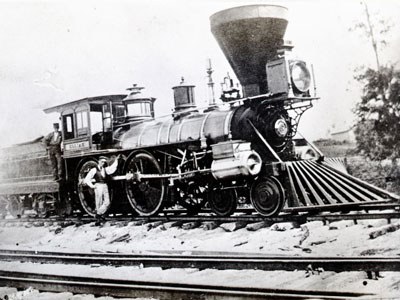
The railroad now connects South Haven with Kalamazoo. Lumber mills, commercial shipping and fishing industries flourish. From 1858 to 1871 the population grows from 200 to 2,000. The first train engine is named “Goliath”. The railroad bed becomes the 34-mile long Kal-Haven Trail Sesquicentennial State Park in 1991.
South Haven based mills manufactured and shipped 12 million feet of lumber this year, mostly to Chicago.
The first commercial bank, First National Bank of South Haven, opens. It converted to a state chartered bank in 1889.
A lighthouse is constructed on the South pier entrance to the Black River. William P. Bryan is the first Lighthouse Keeper. Circa 1874.
The Bark Skinners Base Ball Club is founded. Now known as the Bark Peelers, the vintage baseball team continues to this day sponsored by the Historical Association of South Haven. Bark peeling was an actual occupation paying $1.50 for an 11-hour day.
James S. Donahue begins a 35-year tenure as South Haven’s Lighthouse Keeper (1874-1909).
1877
A fish boat Regatta is held with a parade down the Black River and into Lake Michigan.
St. Basil Catholic parish is formed. The iconic church building that is visible to boaters on Lake Michigan was built in 1923. St. Basil School opened in 1950.
1883
The South Haven Scott Club is organized as a women’s literary club in honor of author Sir Walter Scott. A decade later (1893) the current building opened. A designated Michigan Historical Site, the building features stained glass windows created in Innsbruck, Austria to honor Scott Henry Wadsworth Longfellow.
1884
St. Basil Catholic Church is organized.
1887
The first U.S. Life Saving Station is constructed on the north side of the Black River. In 1908 the building was moved to the south side. In 1915 it became the U.S. Coast Guard Station until it was destroyed by fire in 1989.
The Toledo-South Haven Railroad begins operation. It later became the Pere Marquette and then the Chesapeake & Ohio until being abandoned. The original railroad bed is now the Van Buren Trail State Park. South Haven was unique for a small community in that it was served by two railroad lines. The other was the Kalamazoo-South Haven Railroad which became the Michigan Central and later the New York Central. The two railroad lines intersected near the Yacht Club where they could serve the commercial ships. There were numerous downtown train derailments over the years.
Jewel Rebekah Lodge No. 127, the Auxiliary of Neptune Lodge No. 297 of the Independent Order of Odd Fellows, is organized.
1888
The South Haven Fire Department is organized.
A resort today known as Sleepy Hollow is opened. Tales over the years that Sleepy Hollow and other lakeshore resorts and cottages were once the refuge of Chicago gangsters like Al Capone have never been sufficiently verified. A 1910 fire ravaged the resort and it stood desolate until 1937 when the property was purchased by Richard Gray. He developed a first-class resort advertised as The Aristocrat of Michigan. The art deco architecture of the 1933 Chicago Exposition fascinated Mr. Gray to the point where he had buildings from that event brought across the lake to Sleepy Hollow.
1889
The South Haven Agricultural Experimental Station is established by the Michigan Agricultural College, now Michigan State University. While the development of peaches and blueberries receive most of the attention from historians, credit is also deserved for the development of strawberries, raspberries, pears. At one time South Haven had the best collection of pear varieties in the United States.
1890
The largest canning factory in the world, Dunkley Canning Factory, is operating in South Haven.
1890 & 1891
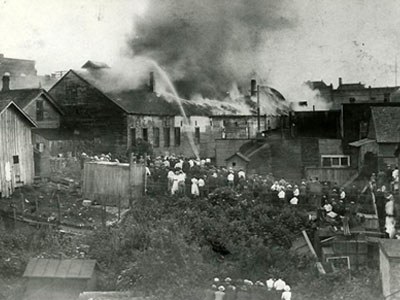
Fire in consecutive years destroys many buildings in the central business district. In 1890, eleven buildings on the Northeast corner of Phoenix and Center Street burned. Firefighting equipment consisted of two Babcock fire extinguishers and buckets. The following year, twenty-two buildings on the corner of Broadway and Phoenix burned.
1892
South Haven’s first water works and storage tower are constructed.
The town hall is built on Phoenix Street. It also houses the fire department which relocated to its Broadway Avenue location in 1925 and then to its current station on Blue Star Memorial Highway in 1991.
1893
Two snowplows to be pulled by horses are purchased for clearing city streets and sidewalks.
1894
The Chicora sinks in Lake Michigan on a voyage from Milwaukee to South Haven with 24 people lost.
1895
South Haven gets into the electric generation business
1896
Over two million baskets and crates for the fruit industry are manufactured by R. T. Pierce & Company. It continued production into the 1940s when other materials were developed for packaging and shipping.
The Oak Telephone Company is established with 50 customers. It has had several owners over the years, and today is operated by Frontier Communications Corporation.
Sergeant William H. Wilcox is awarded the Medal of Honor by President Cleveland for gallantry in the Civil War.
1897
Hitching posts, rails and rings are removed from along the central business district streets.
1898
The Hubbard Street park property is acquired by the city.
Late 1890s
What we know today as Stanley Johnston Park on the city’s north side is opened and named the Grove. It was later named Oakland Park for its many oak trees and in 1969 was renamed Stanley Johnston Park in honor of the developer of the Haven line of peaches. The formal garden along Dyckman Avenue was first created more than 100 years ago.
1900
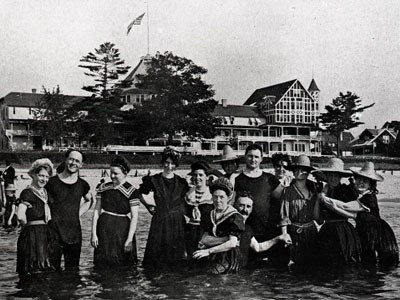
Steamers bring an estimated 160,000 passengers across Lake Michigan this summer. Round trip cost – 50 cents. South Haven has become known as the “Catskills of the Midwest” marking the Jewish Resort Era , a time when the Midwest’s Jewish Community made South Haven its choice vacation spot.
The lighthouse, first erected in 1891, is moved an additional 262 feet to the west, its current position. An effort to move the Van Buren County Seat to South Haven fails.
1901
The German Evangelical Lutheran Peace Congregation was organized at Indiana School. The church was renamed First English Evangelical Lutheran Church in 1942 and then renamed again as Peace Evangelical Church in 2000.
1902
With over 215 resorts, hotels and rooming houses, South Haven becomes incorporated as a city. The Business Directory also shows six blacksmiths, six cigar manufacturers, five ship’s carpenters, one pickle salter, 18 dressmakers and 13 grocery stores.
1903
The steamer City of South Haven is built. It can reach speeds of 20 miles per hour when crossing Lake Michigan. It had a rated capacity of 2,000 excursionists, but was known to have accommodated as many as 3,000 on a single trip. The ship was acquired by the U.S. Navy for service in World War One. She was named the City of Miami in 1919. She was scrapped in 1942.
A rival steamer, the infamous Eastland, is also launched. Over the next decade the City of South Haven and Eastland carry thousands of passengers between Chicago and South Haven. Tragedy struck on July 24, 1915 when the Eastland capsizes while docked in Chicago. A total of 844 passengers and crew died making it the most deadly maritime disaster in U.S. history. More passengers died in this tragedy than in the 1912 sinking of the Titanic.
A steel lighthouse replaces the old wooden structure. The new lighthouse is painted white.
The first city streets are brick-paved, Phoenix from Kalamazoo east to City Hall and Center from Huron to Williams. A year later Williams Street is brick-paved from Center to Dyckman.
The Board of Trade is incorporated for the purpose of attracting industry to South Haven. It transitioned to the South Haven Industrial Fund in 1953.Worshipping in South Haven since the late 1860s, the current Church of the Epiphany Episcopal building is constructed.
1904
A figure-eight roller coaster operates where Jensen’s Fishery is now located on the Black River.
1905
Michigan’s famous Cavalry Regiment is formed in South Haven. It disbanded as a mounted troop in 1940, becoming a Field Artillery and Anti-Tank company serving in World War II before becoming an Engineers Battalion of the National Guard. The armory on Elkenburg Street was built in 1923 and is now owned by South Haven Public Schools.
The manufacturer of quality pianos begins, first by the Cable-Nelson Piano Company and beginning in 1921, the Everett Piano Company. In 1935 an electronic organ, the Everett Orgatron, is introduced. During World War II Everett shifted production from pianos to hardwood caskets. Everett was purchased by Yamaha International Corporation in 1973. The plant closed in 1989.
Carnegie Library, now home to the South Haven Center for the Arts, is constructed. The building, designed by renowned American architect Albert Randolph Ross in the Neo-classic Revival style, was made possible by a $12,500 gift from Pittsburgh steel magnate Andrew Carnegie. The building is still “Dedicated to the Art of Learning”, as was Carnegie’s wish, in the form of visual arts.
1906
A team of horses now pulls the fire department’s hose wagon. Up to now the equipment was pulled by humans. Hardt Insurance opens.
Eight cows are being milked daily at a farm at the corner of Lee and LaGrange Streets. It is the beginning of the Sherman Dairy. The Sherman Dairy Bar on Phoenix Road opens in 1958. Today it remains a popular destination for residents and tourists featuring nearly 70 flavors of ice cream, sherbets and yogurts.
1907
South Haven’s first hospital is located in a rented house on Erie Street. It is re-located to Center and Green Streets when it becomes city-owned in 1919. A new hospital was built at its current Bailey Avenue location in 1942. In 1951 a Joint Hospital Authority was created consisting of the cities of South Haven and Bangor and several townships. It becomes known as South Haven Community Hospital. In 2017 the hospital, with approval from voters, is privatized and acquired by the Bronson Health Care System.
1908
Citizens State Bank was built at the corner of Phoenix and Center streets where Clementine’s is located today. The O.K. Theater opens on Phoenix Street featuring silent movies and serials.
The S.E. Overton Company relocates to South Haven from Chicago. It was known for its production of quality wood products. During World II the company produced over three million gunstocks for the Army.
1910
South Haven’s first Boy Scout Troop is organized. Troop 188 continues to be sponsored by the First Congregational Church. The Great Auto Race of 1910 – from Kalamazoo to South Haven – took the winner 2 hours, 17 minutes to accomplish. Twenty five cars participated; 18 finished.
The railroad depot, now a retail establishment at the corner of Dyckman Avenue and Black River Street, is constructed.
1911
From 1911 to 1920 fine pipe organs were manufactured by Casavant Brothers Organ Builders. Internationally acclaimed, many of these organs remain in use worldwide.
A 38-foot tall white marble Soldiers and Sailor Monument is erected at Lakeview Cemetery. Annually on Memorial Day a ceremony is held at the base of the monument honoring South Haven veterans.
Large pipe organs are manufactured for internationally recognized Casavant Brothers Organ Builders. Many of these organs remain operational worldwide.
1912
The Avery Beach Casino, one of the largest covered dance halls in the country, is built. Many big name bands play there on weekends for the summer resorters. It was destroyed by fire in 1937.
Co-operation between the city and adjoining townships started early-on. In 1912 the townships of Casco and South Haven are given the right to use the city’s Steam Road Roller.
Street lights are installed in the central business district.
1913
The first foreign-based vessel, the Errington Dunford from England, enters South Haven’s harbor.
A new Masonic Lodge is constructed on Center Street. The fraternity is still active at this location.
1914
Campfire Girls is first organized in South Haven.
Sunnybrook Resort opens. It continues today as the Sunnybrook RV Resort.
1915
The steamer Eastland capsizes in Chicago's harbor claiming the lives of 844 passengers and crew. It remains the deadliest maritime disaster in U.S. history.
1916
The first athletic event, a baseball game, is played at Ratcliffe Field. South Haven school district continues using the facility in 2019. First Assembly of God Church begins services.
1917
The fire department acquires its first motorized truck.
Marshall Castings Company and later National Motors is a major supplier of castings to the automotive industry before closing in 1983.
1919
The Edward W. Thompson Post No. 49 on Michigan Avenue overlooking the Black River is formed. In 1960 the original building was destroyed by fire. Included in the lost items was the first American flag flown over Antarctica.
1920
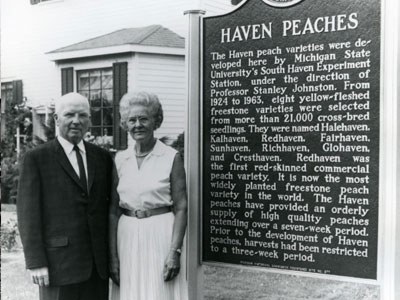
Stanley Johnston becomes superintendent of the Michigan State University Experiment Station in South Haven, serving in that capacity until 1969. He grew and studied more than 2,000 peach trees. The various peach varieties honor this community – Halehaven, Kalhaven, Redhaven, Fairhaven, Sunhaven, Richhaven, Glohaven and Cresthaven. He was called the Picasso among peach breeders. He is also credited with bringing the blueberry industry to the South Haven area. The city during its Centennial celebration in 1969 renamed Oakland Park in his honor. The American Legion Post 49 Auxiliary is formed.
1921
The Sgt. George S. Monroe Post No. 667 of the Veterans of Foreign Wars is formed.
The South Haven Kiwanis Club is formed.
1922
After suffering a fire the year before, the St. Basil Catholic Church is reconstructed on its current site.
1923
Emmanuel Gospel Tabernacle is formed.
1924
A monument honoring Soldiers of World War One is placed in Oakland (now Johnston) Park.
Appleyard Studio opens. Photos by Richard Appleyard and his sons, Mike and Ed, provide South Haven with a rich historically important collection. Richard published three books during his lifetime: South Haven “A Pictorial Review, 1860-1960” in 1976, Images of the Past in 1984 and Photographic Memories in 1996. The Appleyard photo collection was given to the Historical Association of South Haven (HASH).
1925
The South Haven Elks Lodge No. 1509 is founded.
The first traffic lights are installed.
1928
The First Hebrew Congregation synagogue at Broadway Avenue and Church Street is constructed. In 1935 the congregation establishes a cemetery at East Wilson Street and Bradley Avenue.
A summer resident in South Haven, Dr. James Keefe of Chicago, is credited with the first commercial plantings of blueberries in the South Haven area. By 1969 there were an estimated 7,000 acres of blueberries planted in Michigan. In 2018 the acreage approached 21,000 acres.
1930s
The growth of the nation’s highway system to accommodate automobiles, combined with the Great Depression, contributes to the demise of South Haven’s big resort trade. U.S. 31 (now Blue Star Memorial Highway) opened between South Haven and Benton Harbor.
1930
South Haven Garden Club, first known as the Scott Club Garden Group, is organized.
1931
South Haven changes from Central to Eastern Standard Time.
A municipal sewage treatment plant is constructed.
1932
The South Haven Area Chamber of Commerce is formed.
1934
Fleming Brothers Oil Company begins serving the community.
1935
The first air signal (fog horn) is installed on the lighthouse.
1937
Ninety-five babies were born at the city hospital this year. In 2016 the hospital closed its obstetrics department.
Miss South Haven Alice Merson is chosen Miss Blossomtime.
1938
The Ladies Auxiliary to the Sgt. George S. Monroe Post 667 of the Veterans of Foreign Wars is organized.
The Golden Brown Bakery opens. The name was changed to MacKenzie’s Bakery in 1948. In the late 1970s its name was returned to the Golden Brown Bakery. For many years the bakery has generously donated blueberry pies for community celebrations.
1939
The South Haven Yacht Club is established.
The Rose Shop opens its doors.
1940
Bohn Aluminum & Brass operated plants in South Haven until closing in the early 1990s.
Eight fishermen on the tugs Indiana and Richard H. drown in Lake Michigan off South Haven during the Armistice Day Storm. A total of 66 lives were lost on the Big Lake.
1941
The last passenger steamboat departs South Haven on Labor Day.
Miss South Haven Jean Muske is chosen Miss Blossomtime.
1942
South Haven hosts the North American Lightning Class Sailing Championships.
1944
South Haven High School football team goes undefeated. It is an accomplishment not repeated since. South Haven airport is constructed.
1941-45
Forty-one South Haven residents gave their lives in serving in the Armed Forces during World War II.
1947
School bus transportation is provided in South Haven for the first time.
The South Haven chapter of the American Association of University Women (AAUW) is chartered.
The N&R Department Store opens.
1949
Television reception comes to South Haven with the construction of microwave towers that beam signals from Chicago. The towers also allowed Grand Rapids to receive the signals for the first time.
1950
Northwest Orient Airways Flight 2501 crashes into Lake Michigan somewhere between St. Joseph and South Haven with a loss of 58 lives. The wreckage is never found. The remains of several of the lost are buried in South Haven’s Lakeview Cemetery. Natural gas service becomes available in the community.
1951
The first water filtration plant was constructed. A year later fluoride was added to the community’s water supply.
The South Haven Art League is formed by a group of women artists who wanted to create and promote arts in South Haven. The popular outdoor art show held in Johnston Park during Labor Day weekend was started in 1957.
1952
Marine Corporal Duane Dewey, Jr. is presented the Medal of Honor by President Eisenhower for gallantry in the Korean War.
1954
The River Bend Boat Club is founded.
1956
The Rotary Club of South Haven is organized.
1957
Miss South Haven Brenda Tait is chosen Miss Blossomtime.
1958
The library is built at its current location.
1959
The first Girl Scouts troop is organized.
1960
The picking by hand of blueberries is revolutionized with the development of harvester machines that shake the fruit from the plant, first by Blueberry Equipment Company and in recent years by Spencer Manufacturing.
1961
The first commercial radio (WJOR-AM 940) goes on the air. It went off the air in 2012. Since 2008 the community is being served by WCSY-FM 103.7.
L.C. High School opened. Founded in the 1930s as Goldberg Hardware, the store is renamed Wolverine Hardware.
1962
The city manager form of government is adopted.
First Free Will Baptist Church is formed.
1963
The community’s first celebration of the blueberry occurs, today known as the National Blueberry Festival.
Interstate 196 opens connecting Benton Harbor (I-94) with South Haven.
1964
Pentecostal Church of God is formed.
Bethel Baptist Church is organized.
1965
The municipal light plant near the South Beach is closed, but the city continues to own the distribution system.
Controlled Rubber Products begins production.
1969
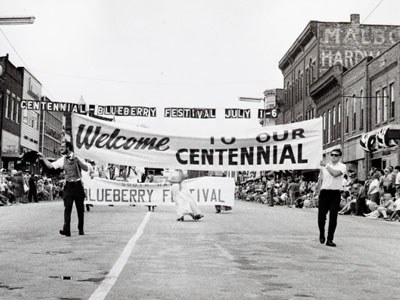
South Haven celebrates its Centennial in conjunction with the National Blueberry Festival during the week of the Fourth of July.
The community’s first celebration of the blueberry occurred in 1963, replacing the previous peach festivals.
The South Haven Daily Tribune celebrates the Centennial by publishing its largest edition (74 pages) ever.
1970
South Haven wins Class B State high school championship in wrestling.
1971
The South Haven Steelheaders, the first chapter of the Michigan Steelheaders and Salmon Fisherman’s Association, is formed.
1972
The Phoenix Road exit (20) to Interstate 196 is constructed.
1973
Elizabeth “Betty” Davis is elected South Haven’s first female mayor. She died at age 100 in 2017.
Black River Park opens.
The new City Hall opens.
1974
Cindy Hill wins the U.S. Women’s Amateur golf tournament.
1975
The Michigan Maritime Museum is conceived. Its building was originally the information center at the Palisades Nuclear Plant.
1950-1975
Seven South Haven residents died in service to their country during the Korean (1950-53) and Vietnam (1955-75) Wars.
1976
Police officer Michael McAllister is shot and killed in the line of duty.
1978
Wyckoff Chemical Company locates in South Haven as a manufacturer of bulk pharmaceuticals. Now owned by the Albemarle Corporation, the plant is South Haven’s largest industrial employer.
1979
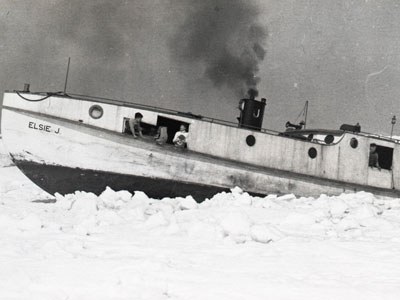
With the change from commercial to recreational fishing on Lake Michigan gaining momentum, the State Department of Natural Resources plants 100,000 Coho Salmon in the Black River. A year later an additional 20,000 Lake Trout and 50,000 Chinook Salmon are planted.
1982
The city’s Downtown Development Authority is created.
1983
The South Haven Area Airport Authority is created consisting of the cities of South Haven and Bangor and the townships of Casco, Covert, Geneva and South Haven.
1984
The book Images of the Past is published containing priceless images of local photographers Arthur D. Moore and Richard Appleyard. It was reprinted as Photographic Memories in 1996 with additional photographs and narrative.
The South Haven Art Association leases the former Carnegie Library from the city. The building becomes the South Haven Center for the Arts in 1990.
1985
South Haven wins the Class B state high school championship in volleyball.
1986
South Haven Hospice opens.
1988
Kids Corner playground opens.
1991
The Kal-Haven Trail Sesquicentennial State Park, a 34-mile long trail converted from an abandoned railroad bed, opens.
1992
South Haven wins the Class B state high school championship in boys cross country.
1996
South Haven Area Emergency Services (SHAES) is organized serving the City of South Haven and townships of Casco, Geneva and South Haven.
1999
Miss South Haven Katie Bugosch is chosen Miss Blossomtime.
2002
The Historical Association of South Haven (HASH) is formed.
2003
A fleet of historic sailing vessels (Tall Ships) grace the South Haven harbor in celebration of the community’s maritime heritage.
2004
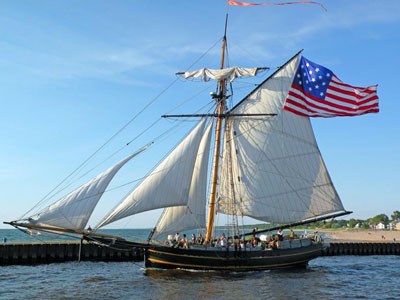
Friends Good Will, a working reproduction of a historical merchant square-rigged topsail sloop (1811-1813) is launched by the Michigan Maritime Museum.
2005
The Greater South Haven Area Community Foundation is established.
2009
Hale’s Department Store, a landmark downtown business, closes after 154 years of service. It was believed to be Michigan oldest family-owned clothing store. Five generations of the Hale family operated the business.
2010
The population of the city according to the U.S. Census Bureau is 4,403. According to Census records the City of South Haven was most populous (6,471) in 1970.The 2017 population estimate was 4,347.
2012
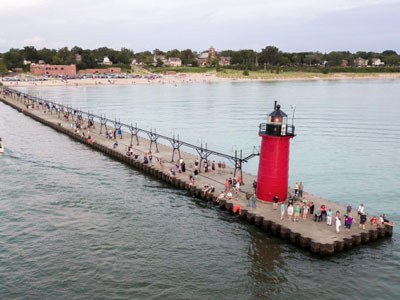
Ownership of the lighthouse is transferred from the United States of America to the Historical Association of South Haven.
2015
The Van Buren Trail Spur, a 2.5-miles-long abandoned railroad bed connects South Haven to the Van Buren State Park.
2016
A community initiative to “Save the Lighthouse” successfully raises more than $300,000 for the restoration project.
2017
The Medal of Honor is bestowed on Army Specialist 5 James C. McCloughan by President Trump for valor as a medic in the Vietnam War.
Bobby Walker, longtime community activist and founder of the Bobby Walker Basketball Tournament, is honored by the State of Michigan.
2019
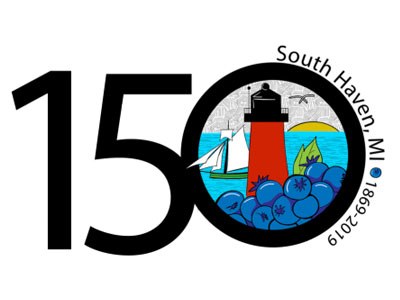
The City of South Haven celebrates its Sesquicentennial. The South Haven Area Regional Airport is named Michigan’s Airport of the Year in the General Aviation Airport Category. Olivia Ellis, a South Haven High School senior and the current Miss Bangor, is named Miss Blossomtime.
2020
According to U.S. Census data, the population of nearby South Haven Charter Township
is larger for the first time than the City of South Haven – 4,041 to 3,988.
South Haven was not immune from the Coronavirus (COVID-19) that swept across the
nation beginning in early 2020. Schools closed for months, businesses were shuttered,
masks became the fashion statement for over a year. According to the U.S. Center for
Disease Control and Prevention (CDC) there were 350 deaths among 22,143 COVID-
related cases in Van Buren County over a three-year-period ending in March 2023.
Lake Arvesta Farm opens as “Michigan’s Ultimate Recreation Park”, featuring 188 acres
of year-round outdoor fun highlighted by a four-lake aqua park. Lake Arvesta started as a
project to mine sand near the legal edge of Michigan’s Critical Dunes and turned into a
collection of man-made lakes providing a place to cool off other than the busy beaches of
Lake Michigan.
The site of the former M. Hale & Co. Department Store in downtown South Haven is
cleared to make way for a future development. Hales, founded in 1855, closed in 2009.
2021
The Forest House was the first hotel in South Haven, built in 1853. The basic structure
still stands on Center Street. In recent years the first floor served an accounting office and
retail store while the upper floors remained pretty much untouched. The building was
acquired by the Historical Association of South Haven (HASH) and transformed into a
visitor’s center with future plans to bring back the downtown hotel.
W.R. Grace Co. acquires the Albemarle pharmaceutical drug substance manufacturing
facility on the city’s south side. The plant, which is South Haven’s largest industrial
employer with an estimated 200 employees, produces more than 40 different custom and
generic products. The company was founded as Wyckoff Chemical in 1976 and has
undergone a series of ownership changes over the years. The company in 2024 completed
a multi-million-dollar expansion at its South Haven plant.
Bronson South Haven Hospital opens a new $22 million facility on site of the former
South Haven Community Hospital. Bronson acquired the hospital in 2017. The state-of-
the-art hospital replaced a building constructed in 1942.
2022
The campus of the Michigan Maritime Museum undergoes a major transformation with
the construction of a new $3.6 million Heritage Center and facility upgrades.
2023
N&R Department Store in downtown South Haven closes after 76 years.
2024

Former U.S. President William Clinton is among national leaders to rally South Haven
voters during the 2024 Presidential campaign.
The South Beacon debuts as a second weekly newspaper in the community, joining the
South Haven Tribune which in 2024 is marking its 125 th year.
Two iconic South Haven businesses, Sherman’s Dairy Bar and the Golden Brown Bakery
close. Sherman’s closed after 66 years on Phoenix Road while the Golden Brown in the
downtown shuttered after 86 years.
Over 150 Years of History
The history of South Haven is one that has revolved around community and industrial growth. From its very beginnings of settlement in the 1830’s, sawmills emerged and provided a means for the construction of buildings. As the town began to shape with a post office, schoolhouse, hotel, and homes by the 1850’s, the development of the fruit industry was underway. Peaches, apples, pears, and much more were cultivated and sold, as Michigan’s fruit belt began to develop. This new industry brought more opportunities for wealth and expansion of the town. By the turn of the century, South Haven was becoming a well-known resort town, with its sandy beaches and proximity to Chicago. While the summers were busy, manufacturing companies kept the city prosperous year-round. All these progressions have brought the city of South Haven where it is today; a historic town alive with annual u-pick blueberry farms, summertime visitors, and long-term residents who appreciate the charm and hard work that has shaped South Haven, as we look to the future while recognizing the accomplishments of the past.